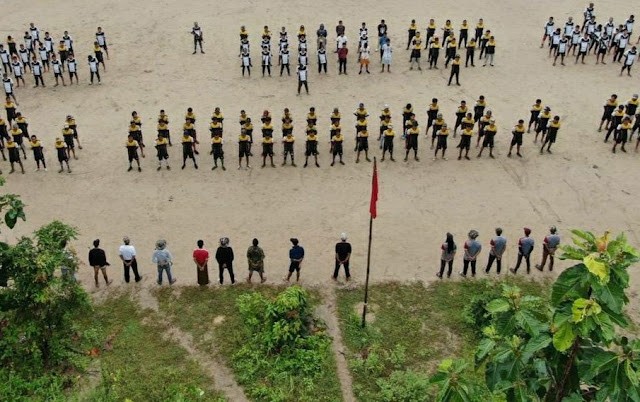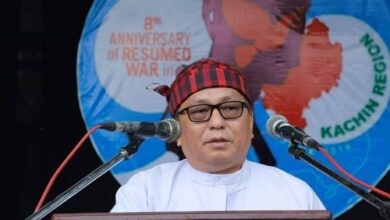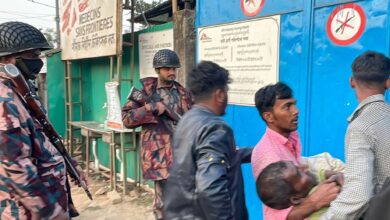
Resistance groups active in eastern Sagaing Region say that regime forces based in the area are using local civilians as human shields in a bid to fend off attacks.
After months of suffering heavy casualties, troops stationed in Ayadaw Township have started forcing villagers to accompany them as they enter areas where they are at risk of being ambushed, the groups said.
“They make civilians go ahead of them when they raid villages. That way, the villagers are injured if we attack, and not them,” said Yaung Pyan, a member of the Ayadaw People’s Defence Force (PDF), one of several local groups fighting the regime.
According to Yaung Pyan, military units based in the villages of Naung Gyi Aing and Magyi Kan have engaged in the practice, which is regarded as a war crime under international law.
The accusation comes amid calls for stiffer sanctions against the regime that seized power on February 1. On Thursday, a resolution adopted by the European Parliament condemned the junta’s gross human rights violations, including its use of violence against protesters.
Anti-regime groups say that the junta’s use of human shields has made it more difficult for them to deploy landmines as a means of targeting troops sent to the region.
“The only way we can overcome this problem is if civilians prepare themselves so that they are ready to flee before troops arrive or when a clash starts,” said Ba Oh, a spokesperson for a group calling itself the Ayadaw Revolutionary Alliance.

Deadly ceasefire
The regime’s offensives in the region have reportedly intensified since it declared a ceasefire with ethnic armed groups active elsewhere in the country late last month.
The ceasefire, which will be in effect until the end of February, appears to be aimed at allowing the military to concentrate on crushing groups that have emerged in the wake of brutal crackdowns on protests earlier this year.
Sagaing Region is likely to be a focal point of the junta’s efforts, as it has been the scene of some of the fiercest fighting since the coup. There are no major ethnic armed groups based in the region.
The regime, which has designated any group opposed to its rule as a terrorist organization, has been pouring reinforcements into the region since mid-September.
According to local sources, raids involving as many as 100 soldiers have been carried out against villages in Ayadaw, Pale, Wetlet, Budalin, Yinmarbin, Kani, Khin-U, and Salingyi townships.
Thousands of residents have been forced to flee from more than 20 villages in Ayadaw Township alone, the sources said.
In addition to using villagers as human shields, army troops have also been accused of massacring civilians, torching houses, and stealing food and valuables.
In one village in Kani Township, soldiers killed 12 residents, including one who was just 14 years old, local residents told Myanmar Now on condition of anonymity.
On October 1, regime troops who raided Pyin Htaung, a village in Khin-U Township, killed a six-year-old girl and four other locals. They also burned down a number of houses, including one belonging to a supporter of the ousted National League for Democracy.
Four days later, at least 20 homes were torched in two villages in Pale Township in retaliation for landmine attacks. Resistance forces claim that at least 50 soldiers were killed by landmines in the township in early October.

Overwhelming force
The regime has been sending more than just ground troops into the region, according to Capt. Zin Yaw, an army defector who has been following recent developments in Sagaing closely.
Lt-Gen Than Hlaing, the junta’s deputy minister of home affairs and chief of the Myanmar Police Force, is also rumoured to be in the region, he said.
The lieutenant general, who was appointed to his current position a day after the coup, is believed to be monitoring police in Sagaing, Zin Yaw told Myanmar Now.
Zin Yaw (who uses a pseudonym to protect his family) said the junta has been pushing forward with its strategy of using overwhelming force to crush the uprising in Sagaing.
“They are focussing all of their energy on carrying out major offensives in the area. That is their best strategy,” he said, explaining that the goal is to break the group into pieces, if not destroy them outright.
“But the resistance groups are not necessarily bound to lose. They could tire the junta forces out if they are clever enough,” he added.
According to Zin Yaw, one of the reasons the junta is so determined to regain control over Sagaing is that it has most of the country’s gold mines, which will help it finance its efforts to quell resistance to its rule through force.
He also noted that PDFs operating in the area are especially vulnerable because of the regime’s close relationship with India, which borders Sagaing Region and Chin State.
“India has a very good relationship with the military council, which means that PDFs in [border areas] won’t be able to cross over to India. I think they only started engaging in this battle after negotiating with India,” he said.

‘Collateral damage’
As fighting intensifies in the region, civilian casualties from the conflict are also likely to increase, local resistance groups warned.
In a statement released on October 7, the Sagaing PDF urged local civilians to stay away from military vehicles and avoid travelling between 7pm and 5am. This was necessary, the group said, to reduce the risk of “collateral damage” in attacks on military targets.
Since September 7, when the shadow National Unity Government (NUG) declared a “resistance war” on the junta, there have been a total of 691 clashes between the military and resistance forces in every state and region except Rakhine, according to the NUG’s Defence Department.
Of this total, 185 clashes have taken place in Sagaing alone, the department said in a statement released exactly one month after the NUG issued its battle cry.
In that month, a total of 952 soldiers have been killed and another 323 wounded, the statement continued. Despite being vastly outgunned, resistance forces say they have not suffered significant losses thanks to their use of guerrilla tactics in the fight against the regime.
Meanwhile, 170 civilians have been killed and 98 injured in attacks by regime forces during the same period, according to the NUG’s official figures.



